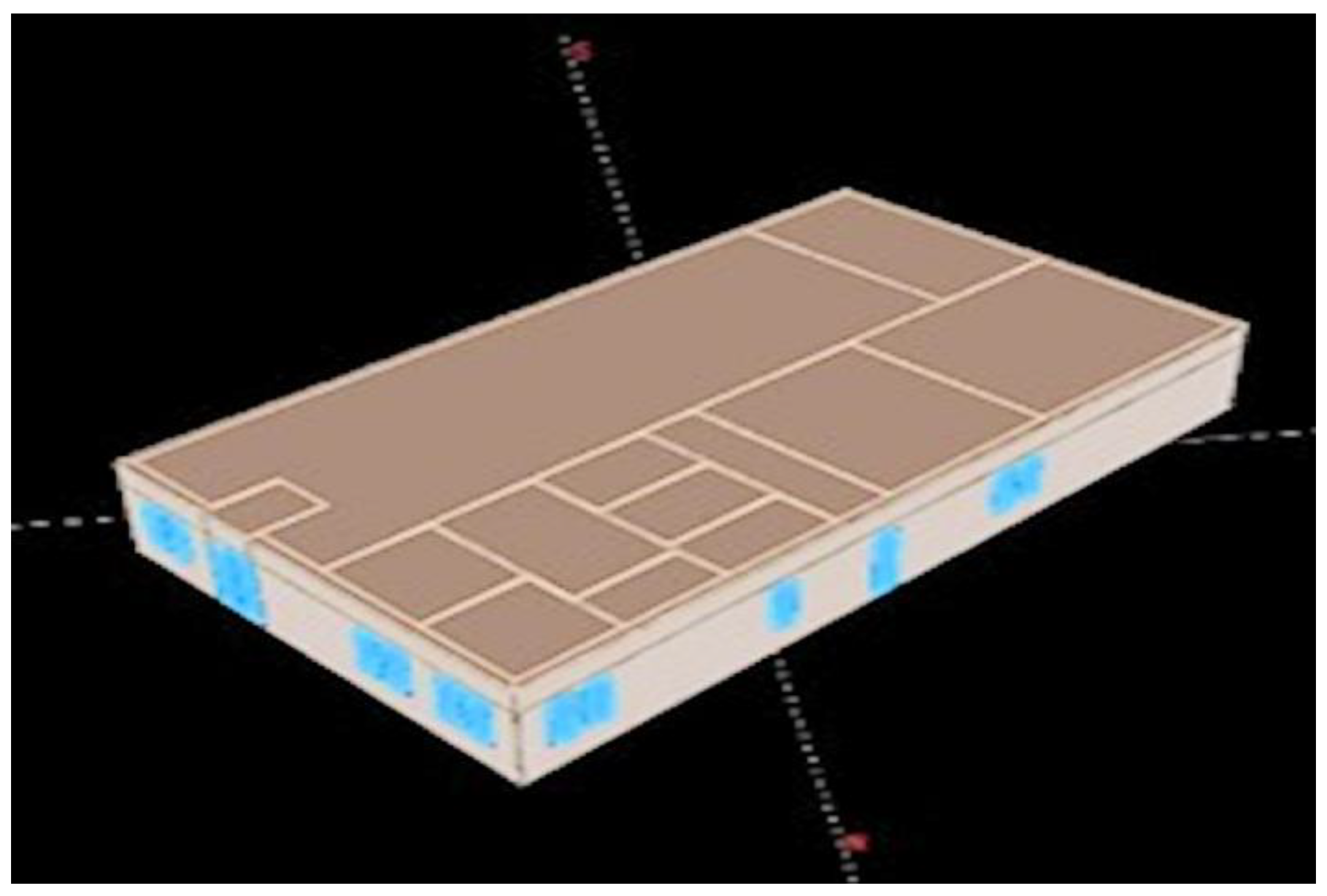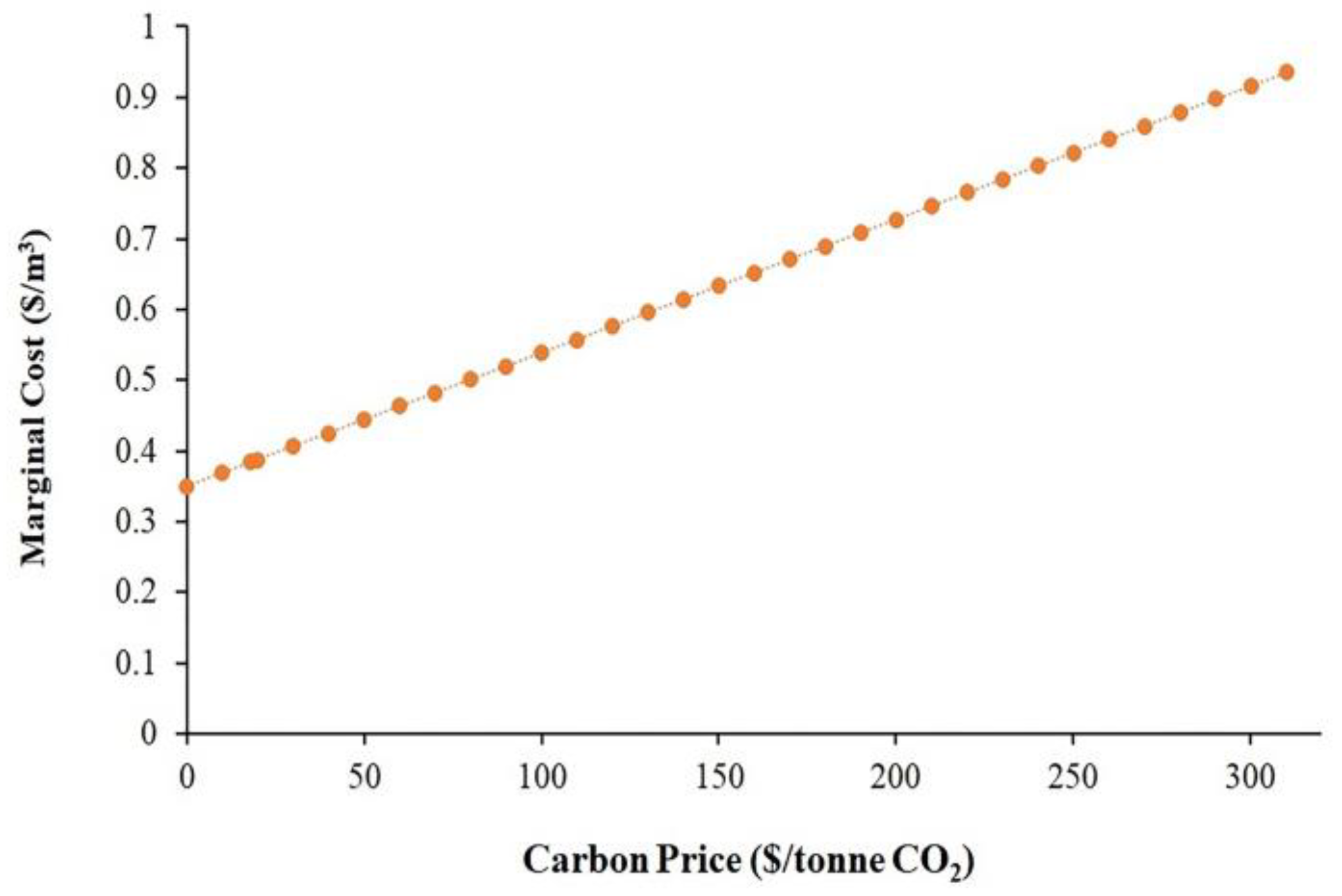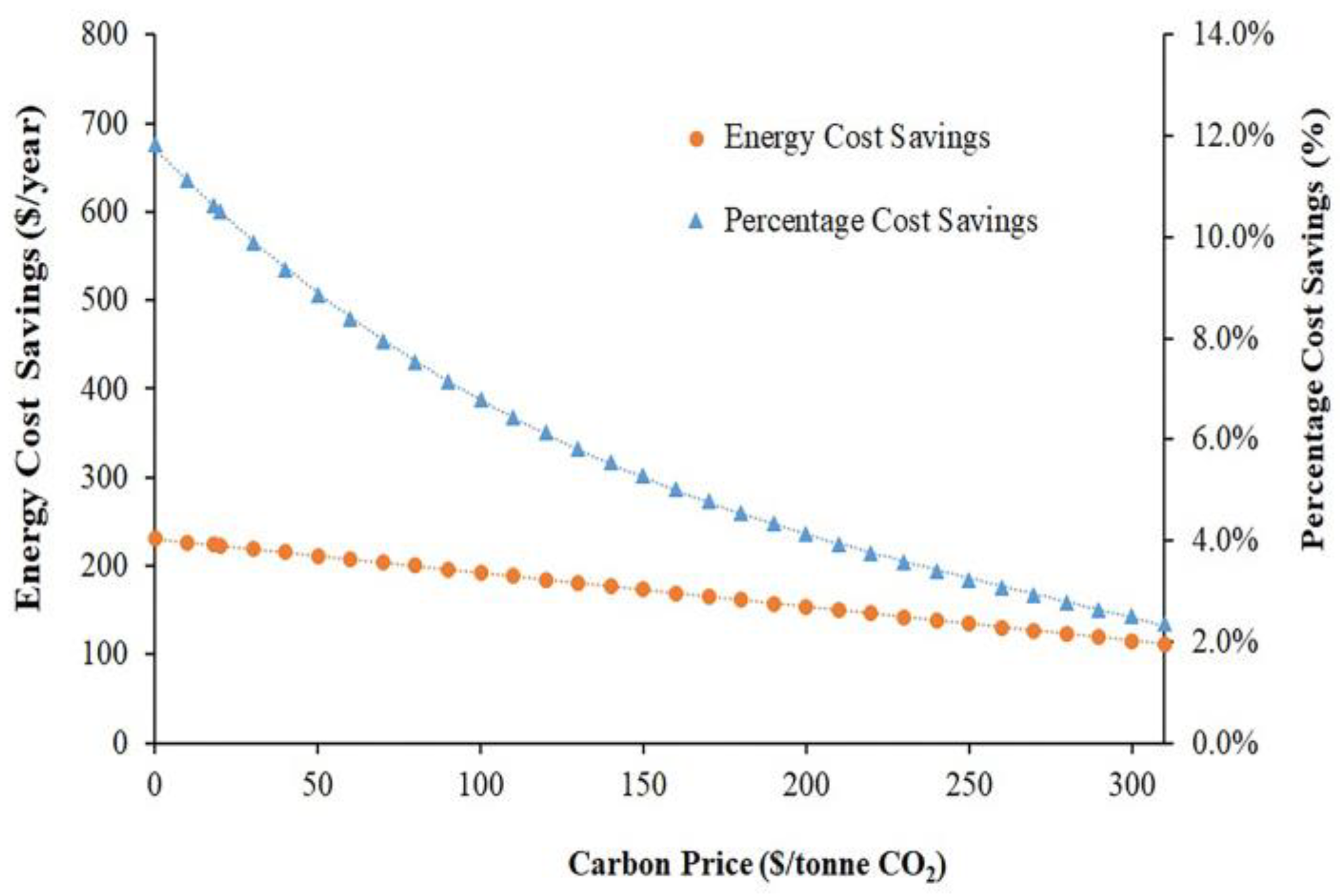1. Introduction
Climate change is one of the most significant issues in the contemporary world. Governments across the globe including the Canadian government have committed to redoubling their efforts to combat climate change through reduction in GHG emissions [
1]. To this end the Canadian government has set targets to reduce GHG emissions [
2]. In Canada steps to reduce the use of fossil fuels include imposing a price on fossil fuel consumption and promotion of electrical heat pumps to replace conventional heating equipment such as furnaces and boilers as they have either reached or are close to reaching their maximum practical efficiencies [
3,
4].
Operating cost of electricity driven heat pumps is a barrier in their adoption. A study by the Independent Electricity System Operator (IESO) showed that the price of natural gas has to increase by at least 50% for electrical heat pumps to be a viable replacement for natural gas-fired furnaces [
5].
In the prevailing circumstances the adoption of alternative heating equipment such as the natural gas-fired heat pump (GHP) can emerge as a viable option for replacement of conventional fossil fuel-fired heating equipment when considering savings in energy and operational cost, and reduction in GHG emissions [
6].
This paper is part of a larger research endeavor to identify and quantify the potential benefits of GHPs i.e., gas engine driven heat pump (GEHP) and gas-fired absorption heat pump (GAHP) in various types of buildings and geographical locations in Canada. This particular paper presents a simulation study, on the potential benefits of a GAHP installed at a library building, using eQUEST. The results were also analyzed considering possible imposition of carbon pricing.
2. Building Energy Simulation
The building under consideration is a single-story library building located in Ontario having 469.8 square meters area. The building is used as a library as well as a venue for community events [
7]. Three units of Robur GAHP-AR have been installed at the library and have been in operation since its construction in 2011. Installation of three units provides the HVAC system with the capability to modulate as individual units can turn “on” or “off” based on the demand rather than just one unit cycling “on” or “off” as the demand increases or decreases throughout the day.
Table 1 provides a summary for the major parameters of the building and the heat pump. Gas utilization efficiency (GUE), which is the ratio of thermal output to energy input from the burner, for the heat pump is 1.26 and 0.6 for heating and cooling respectively.
Parameters from
Table 1, equipment specifications and information regarding building construction were used to create a building energy simulation model in eQUEST shown in
Figure 1. Subsequent to the generation of the model it was calibrated using the energy consumption bills from 2012 to 2014 for comparison, to the point where the model complied with at least one of the established criteria for calibration of building energy simulation models shown in
Table 2.
Normalized mean bias error (NMBE) and coefficient of variance of root mean squared error CV (RMSE) for building energy simulation models were calculated using Equation (1) and Equation (2) respectively [
11].
where
Mi is the measured or actual energy consumption during the i-th period,
Si is the simulated energy consumption during the i-th period,
M is the average of actual energy consumption during the period of simulation and
n is the number of data points in the simulation.
Calibrated simulation model was run for conventional heating and cooling equipment using the minimum acceptable performance specifications legislated under the “Green Energy Act of Ontario” [
12]. According to this regulation for furnaces the minimum annual fuel efficiency (AFUE) is 76% while for packaged air conditioners the minimum required seasonal energy efficiency ratio (SEER) has to be 14.
3. Effect of Carbon Pricing
Carbon pricing was considered to be implemented at
$10/tonne CO
2eq with a gradual increase of
$10/tonne CO
2eq per year. The carbon pricing will cause an addition in the marginal cost of natural gas as shown in Equation (3)
where CP is the carbon pricing (dollars/tonne CO
2eq) and GHG
NG is the GHG emission factor of natural gas considered to be 1.888 × 10
−3 tonne CO
2eq/m
3 [
13].
Marginal cost with carbon pricing was calculated by adding this carbon price component to the average marginal cost of natural gas supplied at the site. The analysis was conducted assuming gradual increase of $10/tonne CO2eq every year from 2017 to 2050. It should be noted that electricity price will fluctuate also and is more likely to increase than decrease but in order to have a conservative estimation of cost saving potential of GAHPs the electricity price was considered to be constant.
4. Results
Three separate building energy simulation models were created for the 2012, 2013 and 2014 and calibrated to be in compliance with International Performance Measurement and Verification Protocol (IPMVP). Seasonal gas utilization efficiency which is defined here as the heating/cooling output in the season to the total energy supplied by gas-fired burner for the season was found to be 1.10 for heating season and 0.58 for the cooling season.
It is evident from
Table 3 that the GAHP in heating mode is more efficient than a natural gas-fired furnace of comparable heating capacity. This results in considerable savings in natural gas consumption which also implies the same percentage reduction in annual natural gas cost for heating and associated GHG emissions.
On the other hand operating the GAHP in both heating and cooling mode diminishes the benefits achieved in the heating season, as shown in
Table 4, because in cooling mode the heat pump is not as efficient as conventional cooling equipment. However, the GAHP still demonstrates positive cost savings on the whole due to the savings achieved in the heating mode.
The average marginal cost for the site increases from
$0.35 at no carbon price implemented to
$0.95 at
$320/tonne CO
2eq as shown in
Figure 2. This increase in marginal cost is bound to have an effect on the cost savings that can be achieved by installing gas-fired heat pumps. It will increase the cost of operating a gas-fired furnace. Such an increase in natural gas price will result in an increase in the monetary value of natural gas savings achieved by using the more efficient gas-fired heat pump for heating.
Imposing carbon price increases the monetary value of natural gas savings achieved in the heating season. On the other hand, as the carbon price increases operating the heat pump in cooling mode becomes more expensive and the cost savings achieved in the heating season would be diminished in cooling mode. However, the heating season in Canada is considerably longer than the cooling season which means the additional cost savings in heating season due to increased natural gas price are sufficient to offset the additional cost incurred in the cooling season. Therefore, monetary value of energy cost savings does not decrease significantly. However, additional cost in the cooling season means that the overall energy cost will increase and the percentage of energy cost savings represented by the monetary value of savings decreases. This is shown in
Figure 3.
It can also be seen that for the year 2014 operating the GAHP in both heating and cooling mode resulted in a net positive reduction in GHG emissions. This shows that depending on the duration and severity of heating and cooling season, the GAHP has the potential to produce net positive environmental benefit while being operated in both heating and cooling mode. To achieve net positive GHG emission reduction consistently GAHP performance needs to be enhanced especially in cooling mode. Alternatively, GAHP performance could be improved in heating mode to make up for the relatively low efficiency in cooling mode. There could be a potential for future research on the performance enhancement of GAHP.
5. Conclusions
In conclusion, a calibrated simulation model for a gas-fired heat pump (GAHP) was created. This model can be used for analyzing potential benefits of GAHP at various locations in Canada. From the results of the simulation it can be concluded that the heat pump under consideration is an excellent replacement for conventional heating equipment. However, operating the GAHP in cooling mode reduces the savings in energy cost considerably.
Analysis of the effects of carbon pricing on the cost savings achieved by GAHP showed that replacing conventional heating equipment with GAHP could be economically beneficial as the increase in cost of natural gas also increases the magnitude of cost savings achieved by operating the GAHP in heating mode. Although operating the GAHP in cooling mode does diminish the energy and cost savings achieved in the heating mode, yet overall GAHP operation results in positive cost savings for the year. The positive effect of GAHP on energy cost savings could still be observed even after imposition of carbon pricing.
For creating a positive environmental impact GAHP operation must result in reduction of GHG emissions produced from energy consumption for cooling and heating requirements of a building. Analysis for GHG emissions of GHPs compared to conventional equipment could be conducted based on the criterion that the reduction in GHG emissions in heating season should be equal to or greater than the increase in GHG emissions in cooling season from operating gas-fired heat pump. This criterion is shown in Equation (4).
This criterion could be useful in setting the performance benchmark for gas-fired heat pumps for operation in heating and cooling mode.
Using the calibrated simulation model, the analyses on potential benefits of GAHP could be performed for other locations in Canada with different weather data, utility pricing, carbon pricing and GHG emission factors for electricity and natural gas. Further analyses would also include economic analysis. Variability of electricity price can also be considered in the future.
Author Contributions
A.A.B and A.S.F. came up with the methodology for modelling the gas-fired heat pump in eQUEST. Under the supervision of A.S.F., A.A.B created the model in eQUEST, analyzed the simulation results and conducted the cost analysis after including carbon pricing. A.A.B wrote the paper while A.S.F. reviewed and edited the paper. Also, A.S.F. was instrumental in funding acquisition.
Acknowledgments
The authors would like to acknowledge the management of library for providing the information required. In addition the financial support provided by MITACS, OCE TalentEdge, NSERC CRD, Union Gas and Enbridge is also acknowledged.
Conflicts of Interest
The authors declare no conflict of interest.
References
- United Nations. Framework Convention on Climate Change. In Proceedings of the Twenty-First Session of the Conference of the Parties (COP), Paris, France, 30 November–11 December 2015. [Google Scholar]
- Canada’s Second Biennial Report on Climate Change. Available online: https://www.ec.gc.ca/GES-GHG/02D095CB-BAB0-40D6-B7F0828145249AF5/3001%20UNFCCC%202nd%20Biennial%20Report_e_v7_lowRes.pdf (accessed on 16 October 2016).
- Murphy, K.P.; Phillips, B.A. Development of a residential gas absorption heat pump. Int. J. Refrig. 1984, 7, 56–58. [Google Scholar] [CrossRef]
- Colosimo, D.D. Introduction to Engine-driven Heat Pumps - Concepts, Approach and Economics. ASHRAE Trans. 1987, 93, 987–996. [Google Scholar]
- Independent Electricity System Operator (IESO). An Examination of the Opportunity for Residential Heat Pumps in Ontario. Ministry of Energy; Independent Electricity System Operator (IESO): Toronto, ON, Canada, 2017. [Google Scholar]
- Ethirveerasingham, K. Energy Modelling and Field Testing of Natural Gas Absorption Heat Pump System in Cold Climate—Canada. Master’s Thesis, Ryerson University, Toronto, ON, Canada, 2018. [Google Scholar]
- Baig, A.A.; Fung, A.S. A case study in energy modeling of an energy efficient building with gas driven absorption heat pump system in eQUEST. In Proceedings of the eSim Building Performance Simulation Conference, Hamilton, ON, Canada, 3–4 May 2016; pp. 695–702. [Google Scholar]
- Fabrizio, E.; Monetti, V. Methodologies and Advancements in the Calibration of Building Energy Models. Energies 2015, 8, 2548–2574. [Google Scholar] [CrossRef]
- IPMVP New Construction Subcommittee. International Performance Measurement & Verification Protocol: Concepts and Option for Determining Energy Savings in New Construction, Volume III; Efficiency Valuation Organization (EVO): Washington, DC, USA, 2003. [Google Scholar]
- FEMP. Federal Energy Management Program. M&V Guidelines: Measurement and Verification for Federal Energy Projects (Version 3.0); U.S. Department of Energy Federal Energy Management Program: Washington, DC, USA, 2008.
- Reddy, T.A. Applied Data Analysis and Modeling for Energy Engineers and Scientists; Springer: New York, NY, USA, 2011. [Google Scholar]
- Energy Efficiency—Appliances and Products under Green Energy Act; Government of Ontario: Toronto, ON, Canada, 2009.
- McCann, T.J. 1998 Fossil Fuel and Derivative Factors; Report Prepared for Natural Resources Canada; TJ McCann & Associates Ltd. and Clearstone Engineering Ltd. for Environment Canada, 2000. [Google Scholar]
| Publisher’s Note: MDPI stays neutral with regard to jurisdictional claims in published maps and institutional affiliations. |
© 2019 by the authors. Licensee MDPI, Basel, Switzerland. This article is an open access article distributed under the terms and conditions of the Creative Commons Attribution (CC BY) license (https://creativecommons.org/licenses/by/4.0/).









